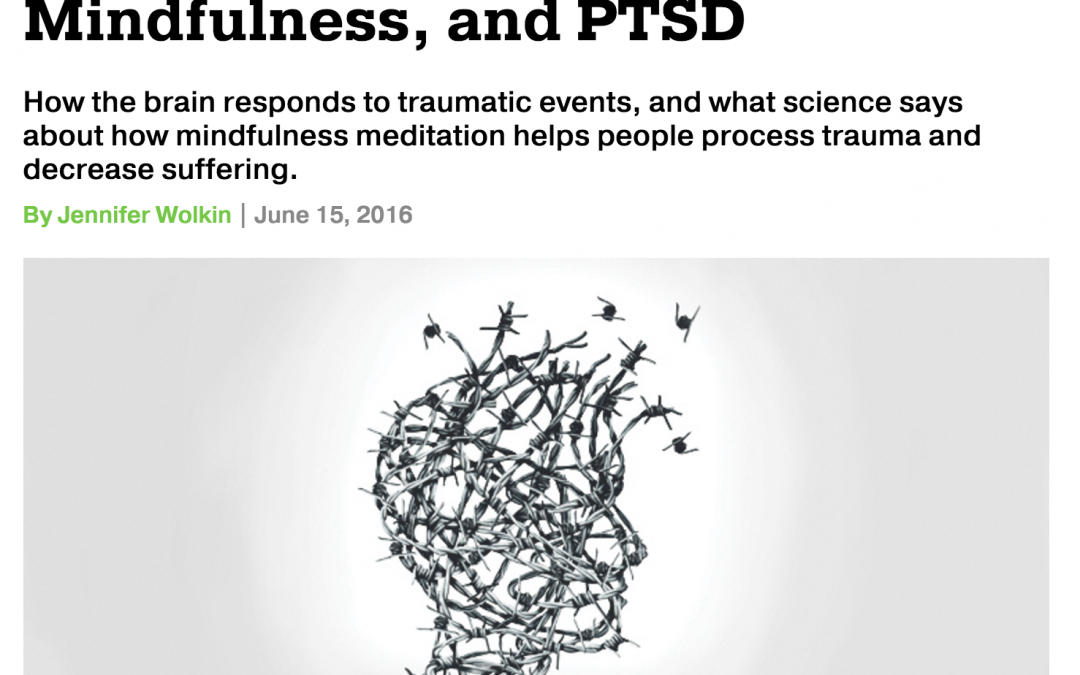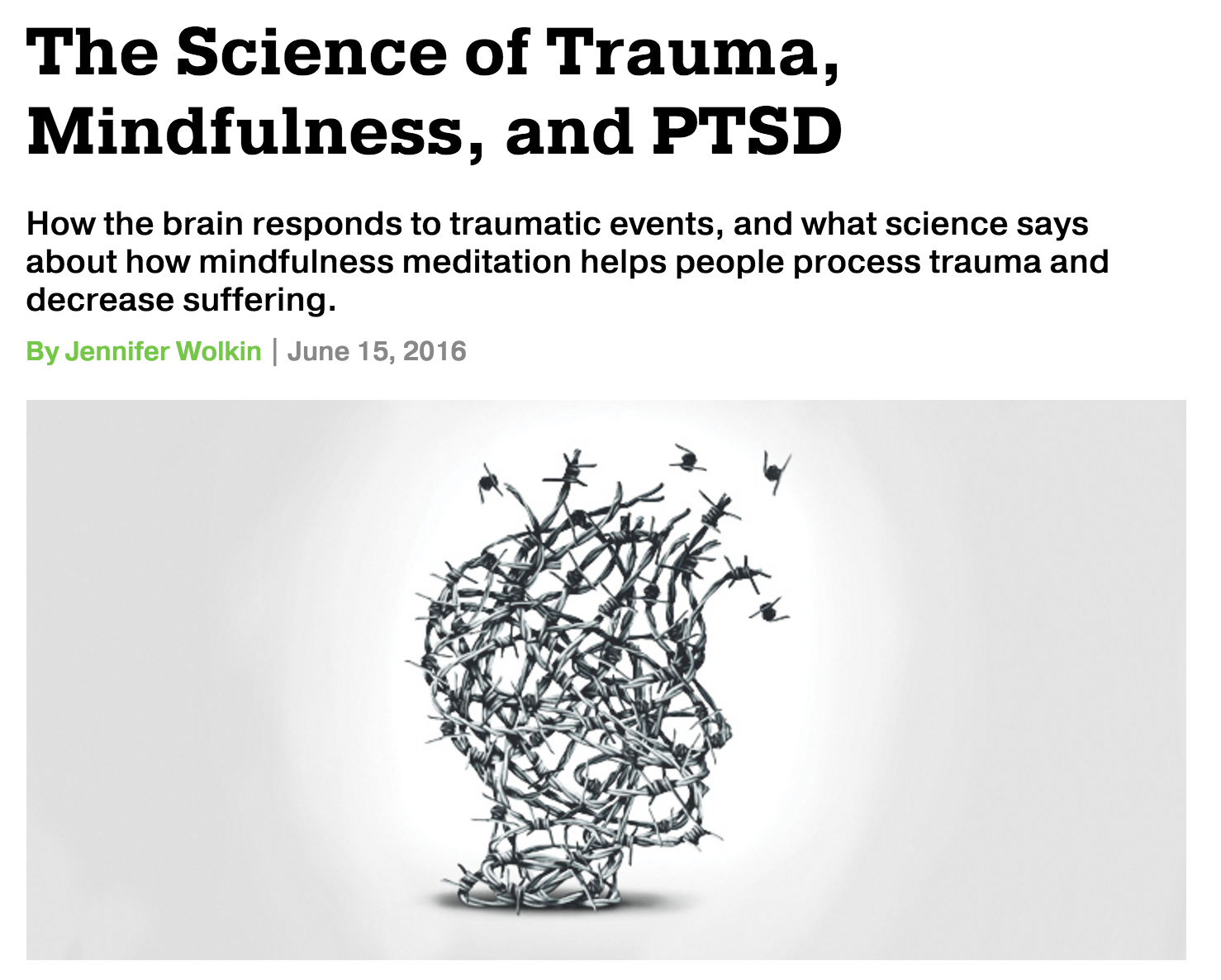
by Jennifer Wolkin | Jun 22, 2016 | Blog, Mindfulness, Wellness
This blog post originally appeared in The Huffington Post.

I feel extraordinary heartbroken at the news of the shooting death of at least 49 human beings who came together in a place they felt safe; a place whose four walls bore witness to love without its shackles. The Pulse nightclub in Orlando, Florida was a place in which lovers could hold hands and kiss, to revel in a feeling of belonging without the still all-to-common threats of discrimination, alienation, and condescension. Inside those doors love was love, until hate walked in.
Hate walked in and obliterated this sanctuary, tearing apart lives that he thought were less worthwhile than his own, and infiltrated the heart and soul of a community and greater world who has had to fight for its birthright; to love and be loved. This is what hate does. He is at once insidious and blatantly hostile, unrelenting, unforgiving, and lacks a conscience. He is heartless and mindless, self-serving and sadistic to the core.
As I grapple with the way hate snuffed the life out of so many vibrant beings this past Sunday, I grieve. I am at once angry, anxious, sad, and shocked. You see, tragedies like these reverberate in the hearts and minds of much of humanity, as it rips through the basic foundation that we lay our trust upon. That is, we don’t expect people to just shoot other human beings in cold blood because of who they are and whom they love.
I am struggling with how to grieve along side you. My own journey of grief includes humbly offering all of us some words about grief from a psychological perspective, and providing five ways to grieve mindfully.
What Grief Is and Isn’t
Psychologically speaking, according to Dr. Kubler-Ross (1969), “Grief is an emotional response to loss.”
This emotional response is conceptualized as a non-linear expression of different stages of feeling states including Denial, Anger, Bargaining, Depression, and Acceptance (aka: “DABDA”).
Biologically speaking, grief is a homeostatic process, a journey that our mind, brain, and body need to engage in, to best recover from the trauma of a loss. This is an evolutionary need, since attachment and connection to others is embedded within our limbic circuitry. Yes, whether we are conscious of it or not, or like it or not, relationships deeply imprint upon our neural circuitry.
Grief is not, by any means, a one-size-fits-all kind of process. In fact, it is a uniquely individual process that often feels amorphous and difficult to capture with words. When it comes to grief, there is no “normal” or typical way to go through it, and despite what some believe, in my opinion, there is no “normal” time period allotted for grief.
It takes a boat-load of self-compassion to allow oneself to feel whatever it is you are feeling at any given time, without judgment, without comparison to another’s explicit portrayal of their own process. In this way, to grieve is to be mindful of our own thoughts and feelings.
While there is no one “right” way to grieve, to actually grieve is essential for our ability to employ our human capacity to find a renewed sense of meaning. Grief elicits resilience and the capacity to continue to hold this tragedy in our hearts and minds, while still forging forward with purpose and direction.
Five ways to Grieve Mindfully
- Accept your feelings: Allow yourself to feel what you feel at any given moment, with a sense of self-compassion, and without judgment.
- Express your feelings: Just as important as accepting your feelings, is expressing them in a way that is helpful to you. Journaling, talking about the experience, scrapbooking, or dancing, for example, are helpful ways to process grief instead of allowing the feelings to stay stuck.
- Reach out: During this time, it is important to reach out in multiple ways. Reach out for guidance from a spiritual counselor or a psychologist. Reach out to share stories of your loved one with others. Reach out to offer support to other grievers. Find a balance between being with yourself, and being with others, but ultimately, reach out – don’t isolate.
- Continue to take care of yourself and others. Living life while grieving often feels like scaling a mountain. Grieving takes energy and can often feel draining. As much as possible during this tough time, continue to eat well, exercise, and maintain wellness practices.
- Celebrate life: It is important through the grief process to keep the memory of the tragic incident alive in some way that inspires healing, but also reflects and honors your mourning process. This can include donating to a charity, meditating on behalf of a loved one or a community, and even planting a tree in honor of the tragedy.
At times like this, many of us are also challenged in our own grieving process to try to explain the unexplainable to others in our life. I, therefore, invite you to also read my post: Five Strategies to Help Us Help Our Children And Ourselves In Times of Trauma.
Today, together as one world and one nation, we are grieving. Here are some resources so that we may process this horrific tragedy together. You are not alone.
Orlando:
- Victim Service Center of Central Florida
http://www.victimservicecenter.org/
- APG Health Behavioral Healthcare
http://www.apghealth.com/
- Psychology Today List of Support and Grief Groups for Victims and Families
http://groups.psychologytoday.com/rms/prof_results.php?city=Orlando&spec=14
NYC:
http://www.centerforbereavement.com/
- NYC Innovations in Mental Health List of Bereavement Groups
http://newyorkcity.ny.networkofcare.org/mh/services/subcategory.aspx?tax=PN-8100.1000
- Psychology Today List of Support and Grief Groups for Victims and Families
http://groups.psychologytoday.com/rms/prof_results.php?state=NY&spec=14
If you don’t see what you are looking for, and need a referral to a psychologist or a support network during this time, please directly reach out to me with your name and a brief paragraph regarding the type of help you are seeking. I will help you find a safe space to grieve. Please contact me at DrWolkin@BrainCurves.com.
With pure love for all my fellow mourners,
Jennifer Wolkin, PhD

by Jennifer Wolkin | Jun 21, 2016 | Blog, PTSD
The meaning of human suffering has been the subject of psychological, philosophical, and poetic inquiry from time immemorial. Yet, there is an angle to trauma that is not talked about half as much as post-traumatic stress is. I’m referring to the upside of trauma, known in the psychological literature as post-traumatic growth (PTG). Research studies indicate that more than half of all trauma survivors report positive change.
PTG is radically changing and advancing our heretofore ideas of trauma and the notion that trauma inevitably means life-long damage. It is challenging the traditional view of trauma as solely destructive and making room for understanding that the struggle that ensues from trauma can be used as a springboard toward growth.

Given the potential zeitgeist shift, it is important to understand a bit more about what PTG really means.
Psychologists Richard Tedeschi and Lawrence Calhoun first coined the term PTG in 1996, after discovering some fundamental ways trauma was changing people for what was reported as “the better”. They define PTG as “the experience of positive change resulting from the struggle with major life crises.”
PTG has been noted as a result of many different types of trauma and stress, including illness, loss, sexual assault, and military combat. Post-traumatic growth is differentiated from resilience, which is akin to “bouncing back”, and connotes “bouncing even higher than before”.
In understanding the concept, however, it’s important to underscore that PTG in no way implies that trauma itself can be intrinsically positive; rather it can be a catalyst for positive change. Despite popular opinion to the contrary, experiencing growth after trauma is much more common than PTSD. While most people will suffer from post-traumatic stress in the aftermath of trauma, few will develop full-blown PTSD, and even of those, most will heal with therapy and time. Many more are likely to go on and become stronger. This doesn’t mean though that everyone who faces a traumatic event experiences growth.
It is also important to note that post-traumatic growth experiences aren’t exclusive from distress. So, just because growth is involved, does not mean that someone doesn’t suffer. In fact, Lawrence Calhoun wrote,
“The process of growth does not eliminate the pain of loss and tragedy. But out of loss there is often gain. And in ways that can be deeply profound, a staggering crisis can often change people for the better.”
Similarly, Stacey Kramer, who suffered a massive brain tumor said so vulnerably in a popular TED talk.
“We can’t wipe away our history and maybe we should not want to. I would not change my experience as it altered my life.”
Some survive from trauma, and others thrive through trauma
Many different variables play a role in cultivating the latter; if one is contextualized within a supportive environment, and maintains an open mindset, the struggle elicited by trauma is more likely to become a conduit for deep reflection, and search for meaning. Research also indicates that there are certain personality traits and mood states that are positively associated with PTG. These include extraversion, optimism, positive affect, and openness to experience.
To conceptualize things more fully, Tedeschi and Calhoun developed five areas in which PTG tends to arise:
- Sometimes when people face a trauma, they begin to see new and positive opportunities knocking. Doors that once seemed shut begin to open up. Many begin to think: “This is possible for me now”.
- After trauma, some people develop an increased sense of personal strength, “If I can survive that, I can get through anything”.
- Some people experience changes in relationships in general or with specific others. Sometimes this includes connecting deeply with those who have had a similar experience of pain. This can sound like, “I have more compassion for others, as we are all just fighting our own hard battles”.
- After trauma, and through healing, many people find a new perspective, and a greater appreciation for life and this moment. For example, “I realize the importance of being present in all aspects of my life, not just my work”.
- Many people begin to experience a deepened sense of spirituality in the context of their healing through trauma. Sometimes, people feel like: “I survived this trauma for a reason and a purpose that is greater than my human comprehension”.
As Richard Tedeschi said, “People’s sense of themselves, their relationships with others and their philosophy of life change. Perhaps one of the most common growth experiences triggered by a major stressor is an increased appreciation of life.”
In my own experiences with people who have suffered through trauma, I have been truly blown away by both the pain that they endure, but also by their innate ability to triumph over that trauma. I don’t think that there is a “cure” for trauma, per se. What I do believe, however, is that a healing process is necessary, and often time serves as a catalyst for a profound awakening to an emotional and spiritual transformation.
Individuals, couples, families, communities, and even nations of this world have the capacity to heal and to grow. Perhaps, in doing so, we can witness both our individual and collective dreams come true.
What are your thoughts? Have you or do you know someone who has had a post-traumatic growth experience? As always, ALL comments are treated with the utmost sensitivity. We’d love to hear your voice!
To Thriving,


by Jennifer Wolkin | Jun 17, 2016 | Blog, Brain Health, Mindfulness, PTSD, Wellness
This blog post originally appeared on Mindful.org

If we were able to prove that individuals suffering from PTSD are experiencing reversible neurological changes, would that help to alleviate any taboo associated with trauma, so sufferers are able to get the treatment they need? New treatment protocols for PTSD that integrate mindfulness techniques may make that a possibility in the near future.
Mindfulness-based techniques in this context have recently gained traction with the support of more empirical findings. Overall, there is a lot of evidence supporting mindfulness as a treatment approach for adults with PTSD, and a recent burgeoning literature corroborating positive neurological changes is following suit.
First, I want to define trauma and PTSD.
Trauma Defined:
Trauma is a broad term, and according to the American Psychological Association (APA), it is an emotional response to a terrible event. Unfortunately, said terrible event can constitute a plethora of possibilities, including combat, rape, natural disasters, and assaults. There are other potentially traumatic events, and though less talked about, are no less palpable. Ultimately, any event might be considered traumatic if you have experienced and/or witnessed a threat to your life, your body, your moral integrity, or had a close encounter with violence or death.
Usually, when we are faced with danger, we go into fight-or-flight mode, during which our bodies release hormones to help us act faster, to either fight or flee. Trauma inhibits this very normal and evolutionary response to danger. What trauma does, instead, is elicit a profound sense of helplessness, during which one feels paralyzed from doing anything to be relieved from the circumstance.
PTSD Defined:
Post Traumatic Stress Disorder or PTSD, is described as a severe response to trauma, and it is most powerfully characterized by three prominent symptoms, which include:
- Re-experiencing the event
- Avoiding any reminders of the event, or feeling emotionally numb
- Hyper-arousal, which consists of a very sensitive startle response
In addition to these three expressions of symptoms, PTSD causes a huge deal of distress and severely limits functioning in many different domains of life. As its name implies, PTSD is technically a “disorder”, and it is listed in the fifth edition of the Diagnostic and Statistical Manual of Mental Disorders (DSM-5).
I respect the need to classify something as a disorder in order for rigorous assessment of specific symptoms that can lead to a comprehensive and individually-tailored treatment plan. Yet, I believe, that there’s nothing truly disordered about having a reaction to seeing atrocities and tragedies beyond our mind’s ability to fathom. To hear more about this point of view, listen to this poignant, sensitive and informative interview with Barry Boyce, editor-in-chief of Mindful magazine.
There’s nothing truly disordered about having a reaction to seeing atrocities and tragedies beyond our mind’s ability to fathom.
The Brain and PTSD
In order to understand the neurological implications of PTSD, it is important to quickly parse the concept of neuroplasticity. For many hundreds of years scientists thought that, like physical development, once the brain reached maturity, it ceased to grow and develop in any way.
The modern view is antithetical to this, given research that continues to show ways in which the human brain is in a constant state of change. In this way, it is believed, new experiences actually impact our neural circuitry; that over the course of a life, our brain map reflects new and changing pathways. This idea is expressed eloquently and through case example in one of my favorite books, The Brain that Changes Itself, by Norman Doidge, MD.
Most of us view this notion of a neuroplastic brain through a rose-colored lens. Yes, neuroplasticity affords the brain an opportunity to heal from injury. Let’s not forget, though, that experience can also negatively change someone’s neuro-profile. So, in sync with neuroplastic principles, when trauma is encountered, the brain changes in response to the event in order to cope and adapt to the situation. These brain changes often don’t serve us going forward. While our brain adapts to develop a psychological defense against further trauma, it is not a brain that thrives long-term.
Neurological Components of PTSD
Neuro-imaging techniques, such as MRI and FMRI, have allowed scientists to examine brains of patients suffering from PTSD. Three of the areas impacted by trauma include the
- Amygdala
- Hippocampus
- Pre-frontal cortex (PFC)
The amygdala is a structure in the brain’s limbic system (known as the emotional seat of the brain) that helps determine whether or not a threat is approaching, and if so, sends out a danger signal, initiates the fight-or-flight response, and then helps indicate when the threat is gone. When one has experienced trauma, the amygdala remains hyper-alert to even non-threatening stimuli, and activates the fight-or-flight response system despite being safe. While experiencing PTSD, the brain can get caught up in a highly alert and activated loop during which it looks for and perceives threat everywhere.
While experiencing PTSD, the brain can get caught up in a highly alert and activated loop during which it looks for and perceives threat everywhere.
The hyperactive amygdala is constantly interacting with the hippocampus, the area of brain that plays a role in memory function. Brain scans have found smaller hippocampi in those with PTSD, perhaps reflecting the impaired memory experienced post trauma. Usually, the hippocampus works to connect and organize different aspects of memory, and is responsible for locating the memory of an event in its proper time, place and context. When experiencing PTSD, memory becomes fragmented, and the hippocampus has trouble coherently piecing together memory, from discriminating from past or present, and from integrating memory of experiences with feelings and factual knowledge. This is an extraordinarily distressing component of PTSD and manifests in the form of intrusive memories and flashbacks. Triggering memories provoke the amygdala, maintaining its hyper-activity.
The third area of the brain affected by trauma is the frontal lobe; specifically, the PFC. This area of the brain is involved in regulating behaviors, impulses, emotions, and fear responses. In those with PTSD, the PFC is notably less active and less able to override the hippocampus as it flashes fragments of memory, nor to signal the amygdala that the danger is not real.
As the above research suggests, the neuroplastic brain indeed responds to trauma. As certain areas of the brain become hyperactive, and others deregulated, throwing off the fine-tuned and exquisite orchestration that usually works to keep someone safe from real threats—PTSD is cultivated.
What are the positive benefits of mindfulness for adult patients suffering from PTSD in relation to the brain?
Mindfulness and the Brain:
There is a significant amount of data supporting mindfulness as a treatment approach for patients with PTSD. Much of the literature, however, doesn’t speak to the neurological changes that occur during the mindfulness process. Research regarding mindfulness mediation’s impact upon the brain in general points to changes in brain structure and function that could account for the reduction of symptoms of PTSD.
Changes in Brain Structure:
As I mentioned earlier, deregulation of the brain areas associated with emotional regulation and memory are key contributors to the symptoms associated with PTSD in addition to the over activity of the fear center, the amygdala. Mindfulness reverses these patterns by increasing prefrontal and hippocampal activity, and toning down the amygdala.
In fact, brain scans confirm that mindfulness meditation is correlated with an increase in gray matter in the hippocampus, a decrease of gray matter in the amygdala, and neuroimaging studies have found that mindfulness meditation also helps to activate the PFC.
Impact on Brain Function:
A recent study looking at the neural functional impact of mindfulness meditation on those with PTSD implicates the interaction of two “opposing” brain networks in mediating beneficial outcomes.
In this study, 23 male veterans who served in Afghanistan and Iraq were divided into different treatment groups, one of which included mindfulness-based exposure treatment (MBET).
Results indicated that while each treatment group showed promise, the men in the group receiving Mindfulness-Based Exposure Therapy (MBET) experienced actual post-treatment brain changes that indicate mechanisms by which mindfulness could potentially help in the treatment of PTSD.
Functional magnetic resonance imaging (fMRI) indicated that at the start of the study, the veterans showed increased activity in regions associated with perceived external threats. After receiving MBET, fMRI showed increased activity in what is known as the brain’s default mode network (DMN). The DMN consists of interacting brain regions associated with internally focused meandering and wandering thought. Additionally, fMRI also showed that the DMN increased its connections with what’s known as the Executive Network, associated with the purposeful shifting of attention.
Both these networks were working in sync, providing insight into how mindfulness can help people train themselves to get unstuck from a vicious cycle of negative thinking, often a cornerstone of trauma.
…Mindfulness can help people train themselves to get unstuck from a vicious cycle of negative thinking, often a cornerstone of trauma.
The small sample size, the gender bias of the group, and the inclusion of only veterans means that there is room for much more extensive empirical exploration with regards to mindfulness as applied specifically to those with PTSD.
Mindfulness and PTSD:
Overall, these neural correlates of symptom reduction can potentially shed light on the therapeutic possibility of mindfulness-based treatments going forward. There is, without a doubt, great potential for these treatments in helping people better process trauma, and hopefully decrease a lot of potential suffering.
Yet, a caveat worth heeding: Given the precarious nature of the symptoms of PTSD, the most efficient and safe treatment should only be obtained by a professional. It is my opinion that mindfulness, as an integrative approach under professional supervision, is the most prudent.
In honor of PTSD awareness month, I invite you to learn more about the various aspects of PTSD as it relates to gender, relationships with others, chronic pain, heart health, and brain injury.
Please click here to download my free resource packet on PTSD. Inside you will also find helpful quotes and resources related to trauma and PTSD, and NEW this year, I have included an additional post on an oft-forgotten element of trauma: Post Traumatic Growth.
Download Dr. Wolkin’s BrainCurves: PTSD Reference Packet here.

by Jennifer Wolkin | Jun 15, 2016 | Blog, PTSD, Relationships, Wellness
In honor of PTSD Awareness Month, and in response to the tragedy in Orlando, I offer five ways to help us help our children and ourselves in times of trauma.

- Give Yourself Permission to Feel Many Emotions at Different Times:
One of the core concepts of mindfulness meditation is the idea of having an attitude of non-judgment of, and openness towards, current experiences. After a tragedy, it is natural to react with shock, anger, numbness, sadness, grief, confusion, and even denial. Most often, grieving is not a linear process and you might experience yourself fluctuating between different feelings at different times, on different days and during different weeks. It is okay. Allow yourself to feel what you feel with as little judgment as possible.
- Take Care of Yourself, Then Take Care of Others:
This is true on any given day, but most importantly at a time like this. If you are anxious and your symptoms continue to persist, please reach out for support/professional guidance. More than ever, make a point to engage in your usual routine. Eat well and sleep well. Engage in healthy coping strategies (breath from your diaphragm, take a bath, journal, watch a comedy, create your own safe space and let yourself cry). Managing your own stress is a precursor to helping your children manage theirs.
- Create a Sense of Safety:
For most children, their parents symbolize safety. In times of doubt, children look to their primary attachment figures to cultivate a safe space. Let your children know you are available if they have questions and actively make yourselves available. Children don’t yet have the same cognitive tools needed to cope. Model resilience in the face of hardship without denying that hardship.
- Recognize, Be Real, But Reassure:
It is important to recognize signs of your children’s distress. Sometimes it is not obvious, as fear and anxiety might manifest as physical symptoms (stomach aches and headaches) and/or insomnia (and other sleep difficulties). Children, especially teens, might isolate and/or withdraw. Recognize the pain. Then, it is important to be real with your children. Limited media exposure is a crucial element, but on the flipside, children need to know what happened. If your children do not approach you, take the time to find out what kinds of questions they are having and what kinds of feelings they are experiencing. Use discretion (talk to them in an age-appropriate way) and be honest about what is happening; it is important not to deny the events. After honest, but age-appropriate and discrete discussion, reassure your children’s sense of safety. At this juncture, they are internalizing and probably deeply personalizing the events, wondering “when will something happen to ME.” Reassure through returning to normal routine and sending messages of safety overall. Keep life feeling as safe and predictable as possible under the circumstances.
- Reassess and Regroup:
Different people, of different ages, express trauma differently, at different times. The reaction to trauma will vary greatly. One thing, however, is for sure: The effects of trauma don’t go away easily. They might remit or decrease in severity, but they usually ebb and flow for a very long time.Healing is possible and there is hope amidst this gripping grief. As children develop they will adopt more evolved coping skills in order to adapt, and ideally the appropriate acute treatment will serve as a tool to cultivate increased resilience as time goes on. Yet, continue to reassess and regroup. It is important to continue to check in with yourself and your children if symptoms reemerge, or if other traumatic circumstances arise.
*If you need a referral to a trauma specialist, please contact me at DrWolkin@BrainCurves.com.
To Healing,
Jennifer Wolkin, PhD








